Sun stone (Piedra del Sol) › What is it, Characteristics, Symbols
Sun stone (Piedra del Sol)
What is the Stone of the Sun?
The Stone of the Sun, erroneously called the Aztec calendar, is a monolith that represents the way in which the Aztecs conceived of time according to their worldview.
It is estimated that it was built by the Aztecs (also known as Mexica) between 1250 and 1521 AD, just before the process of European conquest and colonization.
For a long time it was assumed that the Stone of the Sun was the calendar of the Aztecs. The great richness of the carvings of symbols, ideograms and other details referring to time prolonged this confusion.
The Stone of the Sun contains, for example, the ideograms of the 20 days of the Aztec solar cycle, but it lacks certain elements to be a calendar. Neither are the months of the solar cycle represented, nor the ritual cycle of the Mexica.
On the other hand, the Aztec name of the Stone of the Sun is Cuauhxicalli , which has been interpreted as "glass of the eagles". This name, the concave shape of its central figure, and some historical records have served to suggest that the monolith was, in fact, an artifact created for sacrifices.
Therefore, everything indicates that it did not work as a calendar. A calendar organizes time, while the symbols and elements contained in the Stone of the Sun only show us a representation of time according to the understanding of the Mexica people.
Meaning of the symbols of the Stone of the Sun

La Piedra del Sol is a basalt rock monolith of 3.60 meters in diameter and 25 tons in weight that is in the Museum of Anthropology and History of Mexico.
It is composed of a series of concentric circles with symbols or ideograms that synthesize the idea of time that the Mexica had according to their way of conceiving the world and its history.
First circle (Fifth Sun)
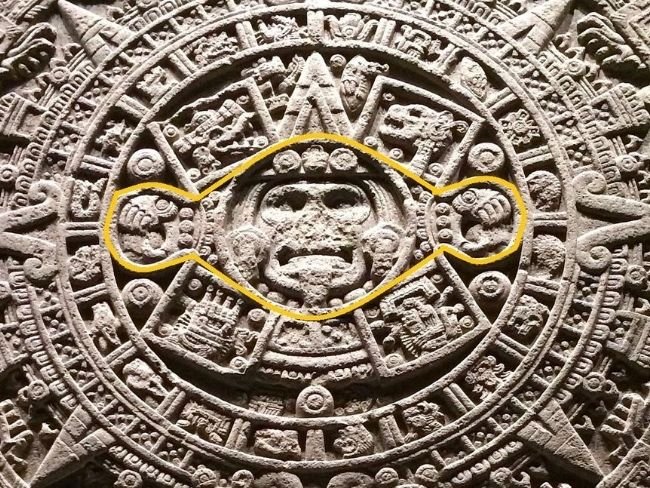
The Aztecs divided time into suns or ages. Each era was presided over by a deity. Each of these eras or suns had a beginning and an end, which was precipitated by catastrophes.
In the first circle, the Stone of the Sun contains the symbol of the Fifth Sun, called Tonatiuh , which represents the current era. Two eagle claws emerge from it (which could explain the name Cuauhxicalli or glass of eagles). He also has a knife instead of a tongue, as Tonatiuh feeds on blood to continue existing.
For the Mexica people, ritual sacrifices had a sacred function, since with them they fed the sun of their era in order not to perish.
Second circle (the four suns or eras)
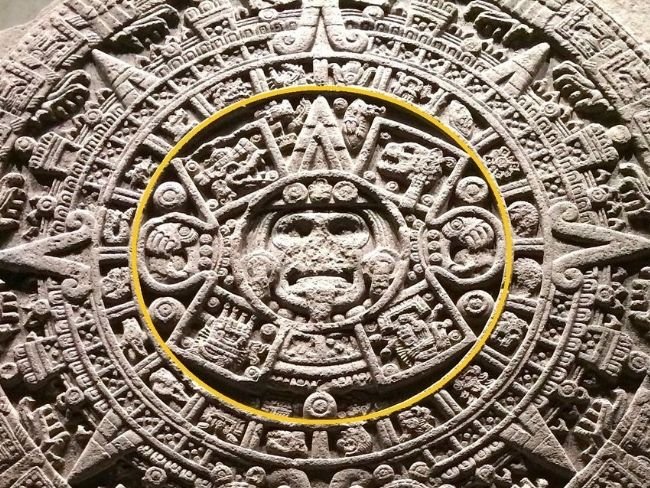
It contains the four suns or eras preceding the Fifth Sun and they are read counterclockwise:
- Sun 4 Wind (Nahui ehécatl ): A 364-year era that ended when hurricane-force winds swept through the world and turned living things into monkeys.
- Sun 4 Rain of Fire ( nahui quiáhuitl ) : a 312-year era that ended with a rain of fire.
- Sun 4 Water ( nahui atl ) : an era of 676 years, of which the last 52 were under heavy floods that turned human beings into fish.
- Sun 4 Jaguar ( Nahui océlotl ) : a 676-year era that ended when human beings were eaten by animals.
On the other hand, the suns or eras represent the four elements of nature (air, fire, water and earth) and together with the fifth sun they form Ollín , the symbol of movement.
Third circle (days of the month)
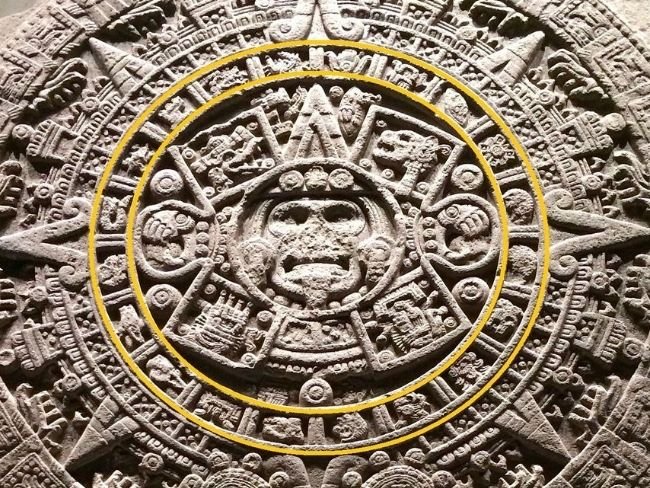
The four suns or eras are surrounded by a circle containing 20 ideograms that correspond to the 20 days of the Aztec month. Each day of the month had a name associated with an element of nature.
- Cipactli (alligator)
- Ehecatl (wind)
- Calli (house)
- Cuetzpallin (lizard)
- Cóatl (snake)
- Miquiztli (death)
- Mazatl (deer)
- Tochtli (rabbit)
- Atl (water)
- Itzcuintli (dog)
- Ozomatli (monkey)
- Malinalli (grass)
- Ácatl (reed)
- Ocelotl (jaguar)
- Cuauhtli (eagle)
- Cozcaquauhtli (vulture)
- Ollín (movement)
- Tecpátl (obsidian)
- Quiahuitl (rain)
- Xochitl (flower)
Fourth circle (Venusian cycles)
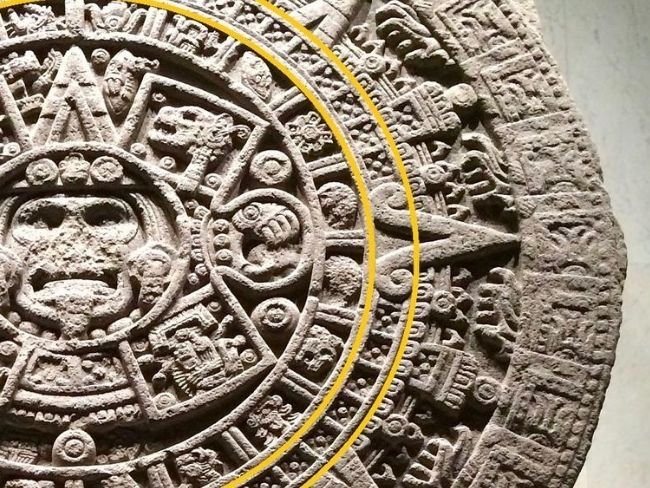
This ring is made up of 40 sections of five points called quinqunces (figures of five points that form a quadrilateral) and 8 triangles or rays.
The quinqunces have been interpreted as a symbol of the movements of Venus, since for every five turns of this planet around the Sun, 8 years of the solar or civil cycle have passed, which when multiplied gives 40.
Fifth, sixth and seventh circle
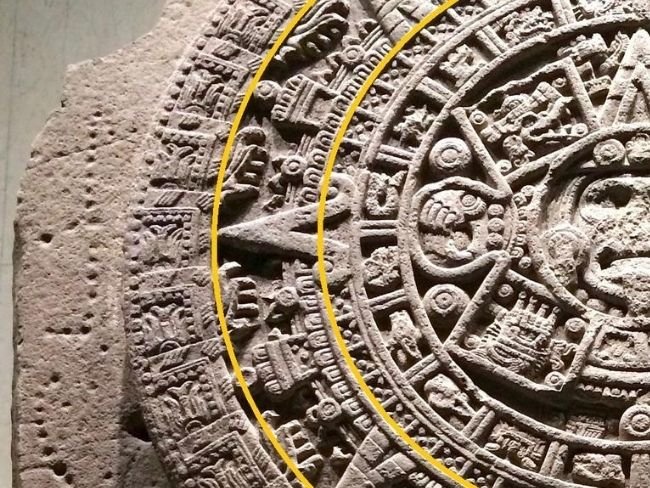
In these sections there are different elements, such as figures in the shape of arches, feathers and other details from which various interpretations have emerged: the union of the sky and the Earth, the planets Mars, Mercury and Saturn or the Milky Way.
Eighth circle (duality)
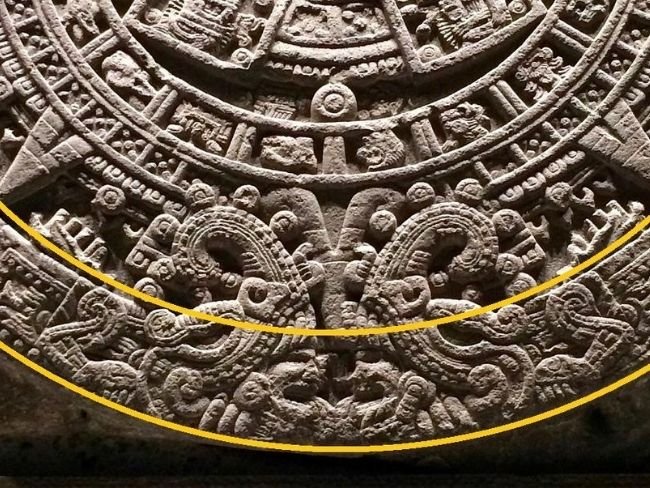
This last ring has two fire serpents or xiuhcoatls facing each other and surrounding the entire monolith with their tails to "close" the stone. They are believed to represent dual concepts such as day and night, east and west, heaven and earth, etc.
In this circle there is also the glyph that represents the day 13- acatl or 13-cane, which corresponds to the year 1479, which has been taken as the date of completion of the monolith.
History of the Stone of the Sun
The Stone of the Sun was in the center of Mexico-Tenochtitlán, capital of the Aztec empire, until the arrival of the Spanish in the 15th century. Then it was moved to the Templo Mayor, near the Viceregal Palace, where it was exposed until Alonso de Montúfar, archbishop of Mexico, ordered to bury it.
On December 17, 1790, Piedra del Sol was discovered while urban works were being carried out in the Mexican capital. It was then when it was given the name of the Aztec calendar, since it was believed that it was an ancient artifact to measure time.
However, researchers such as archaeologist Leonardo López Luján, director of the Institute of Archeology and History of Mexico, agree that the Stone of the Sun could be a recipient for sacrifices, rather than a calendar.
In addition, although the stone has some elements of the calendar, they are only a synthesis of the vision of time of the Mexica, since there is not everything that is required to keep the accounts of the cycles. For this reason it would be impossible to measure time using this structure.
Update date: 08 February 2021
Recommended content
- Friendship defines in 15 sentences
- Generosity: definition and examples
- Globalization › What is it, Characteristics, Origin,
Types
- Gross National Product (GNP) › What is it,
Characteristics
- How to Protect Yourself from Coronavirus COVID-19
(Tutorial with Images)
- Love: the meaning of "I love you"
- Meios: definition och faser
- Pentecost: etymology and meaning
- Pollution: causes and consequences
- Primary colors: What are they, Characteristics,
Systems